HM Prison and Probation Service workforce quarterly: September 2024
Published 21 November 2024
Applies to England and Wales
Main Points
| 65,201 FTE (full time equivalent) staff in post | This is an increase of 1,316 FTE (2.1%) staff in post compared to 30 September 2023 and a slight increase of 422 FTE (0.7%) since 30 June 2024. The increase seen over the last year is largely because Public Sector Prisons have increased by 1,105 (3.0%), and probation staff have slightly increased by 224 (1.1%). The increase in prisons staff will be partly due to the introduction of Lowdham Grange from the private sector, further details below. Of the staff in post, there were 37,570 FTE in Public Sector Prisons (PSP), 20,652 FTE staff in the Probation Service, 5,557 FTE staff in HQ and Frontline Support, and 1,421 FTE in the Youth Custody Service (YCS). |
| 23,571 FTE band 3-5 prison officers in post | This is an increase of 581 FTE (2.5%) since 30 September 2023 and small decrease (42 FTE (0.2%)) compared to 30 June 2024. |
| 5,592 FTE band 2 operational support staff in post | This is an increase of 205 FTE (3.8%) since 30 September 2023 and a slight increase of 36 FTE (0.7%) operational support staff since 30 June 2024. |
| 5,436 FTE band 4 probation officers in post | This is an increase of 546 FTE (11.2%) since 30 September 2023 and an increase of 276 FTE (5.3%) compared to 30 June 2024. In addition to the band 4 probation officers, there were 5,586 FTE band 3 probation services officers: a decrease of 1,004 FTE (15.2%) since 30 September 2023 and a decrease of 321 FTE (5.4%) since 30 June 2024, caused by a lower number of trainee probation officers this year. |
| Leaving rate of 12.8% amongst band 3-5 prison officers | This is a decrease of 0.3 percentage points compared to the year ending 31 March 2024. The overall leaving rate across HMPPS over the past year stood at 11.4%, which is a slight decrease of 0.2 percentage points compared to the year ending 31 March 2024 of 11.6%. |
| Leaving rate of 7.8% amongst band 4 Probation officers | This is a slight decrease of 0.2 percentage points compared to the year ending 31 March 2024. The leaving rate of band 3 probation services officer over the past 12 months was 12.1%, which is no substantial change compared to the year ending 31 March 2024. |
This publication provides details of staffing levels, staff inflows and outflows, sickness absence rates, and protected characteristics for the directly employed workforce of HMPPS. Information presented covers PSP, the Probation Service, the YCS, HMPPS headquarters, and Frontline Support which provides direct operational support. Technical details and explanatory notes can be found in the accompanying Guide to HM Prison and Probation (HMPPS) Workforce Statistics.
Statistician’s comment
In this publication we are reporting on the HMPPS workforce as at 30 September 2024.
Lowdham Grange came into the public sector from the private sector on 1 August 2024, and so are now included in these statistics. They are included in the staff in post figures for this quarter but are not treated as new joiners so are not included in the joiners data.
As at September 2024, there were 65,201 FTE staff in post which was an increase of 1,316 FTE compared to September 2023. This increase was mainly due to increases in Public Sector Prisons which saw an increase of 1,105 FTE (3.0%), with a particular increase in the number of bands 3-4 / prison officer (incl. specialists) of 583 FTE (3.0%), of which 214 FTE will be due to introduction of Lowdham Grange. Some Probation Service grades also saw an increase with there being an increase of 546 FTE (11.2%) probation officers over the same period, as well as other bands 4-6 (18.3%) and other bands 1-3 (7.3%). The exception is probation services officers where there has been a decrease of 1,004 FTE. A contributing factor to this net decrease is the qualification of trainee probation officers, with many qualifiers taking up posts at the band 4 qualified probation officer grade. Another factor is that following high recruitment volumes for trainee probation officers in previous years (over 4,000 recruited in the three years to March 2023), we have seen a lower number of trainee probation officers who started on a course in the most recent financial year (543 in 2023/24 compared to 1,514 in 2022/23), which has contributed towards this net decrease.
Since June 2024, there has been a minimal increase of 422 FTE staff in post (0.7%) across HMPPS. There were 23,571 FTE band 3-5 prison officers in post in September 2024, which is a small decrease of 42 FTE (0.2%) compared to June 2024 and a slight increase (36 FTE (0.7%)) in band 2 operational support staff in post. 5,436 FTE band 4 probation officers were in post in September 2024 which is an increase of 276 FTE (5.3%) compared to June 2024.
The overall leaving rate across HMPPS was 11.4% in September 2024, representing a decrease of 0.2 percentage points compared to the year ending March 2024. Leaving rates fell during the COVID-19 pandemic, possibly due to increased uncertainty in the employment market. Although the overall leaving rate of 11.4% in the year to September 2024 is still higher than pre-pandemic levels, it has decreased slightly by 0.2 percentage points compared to the overall leaving rate in the 12 months to 31 March 2024. In the 12 months to 30 September 2024, there was a total of 8,221 staff who left HMPPS, which is an increase of 490 (6.3%) compared to the year ending 30 September 2023. This increase was driven by the HQ and Frontline Support areas which saw an increase of 238 (53.2%) in the number of leavers compared to the year ending 30 September 2023. The leaving rate of band 4 probation officers was 7.8% in September 2024, which represents a decrease of 0.2 percentage points compared to the year ending March 2024.
Points to note
HM Prison and Probation Service
HMPPS is focused on supporting operational delivery and the effective running of prison and probation services across the public and private sectors. HMPPS works with a number of partners to carry out the sentences given by the courts, either in custody or the community. This publication covers the reporting period up to 30 September 2024 and therefore considers in detail quarterly staffing levels and staff inflows and outflows, for HMPPS and its predecessors, since 1 April 2018.
For ease, the statistics in this publication will be referred to as those of the HMPPS workforce (i.e. staff working in HMPPS and with a contract of employment with HMPPS, excluding all staff who were not an active member of the workforce and receiving pay on the relevant date from our staff in post counts, and those on secondment or loan outside of HMPPS but including staff on secondment or loan into HMPPS).
Staff employed by private sector establishments and other contractors are excluded. Community Rehabilitation Companies (CRCs) were private-sector suppliers of Probation and Prison-based rehabilitative services for offenders in England and Wales. In late June 2021, more than 7,000 staff from the CRCs came together with probation staff already in the public sector to form the new Probation Service. Prior to this movement, staff employed by CRCs were excluded.
Annex on HMPPS recruitment diversity
This annex, with accredited official statistics in development, presents figures on Prison Officer and Operational Support Grade (OSG) recruitment by diversity characteristics. From June 2021, recruitment statistics were introduced for HMPPS overall, HMPPS HQ and Frontline Support, Public Sector Prisons (including the YCS) and the Probation Service. This annex runs on a six-monthly production cycle and is only included in the June and December editions.
Annex on Prison and Probation Officer Vacancies and Trainees
As of the June 2019 publication, this annex has been added to this bulletin which presents figures on Probation Officers in post, and their required staffing level, in addition it shows the number of trainee and qualified Probation Officers. Following on from the March 2024 publication, we have published quarterly hours adjusted Staff in Post, Target Staffing and Difference at establishment level for Band 3-5 Prison Officers.
Annex on ‘Great Place to Work for Veterans’ recruitment
This annex was introduced in 2022 and presents figures on staff recruited as part of the ‘Great Place to Work for Veterans’ recruitment campaign. This campaign started in April 2022. It is a simple one table annex and is expected to be repeated biannually, in the March and September publications. All externally advertised roles, at all grades across MoJ, utilise the Great Place to Work for Veterans scheme. This scheme allows eligible veterans to opt into the scheme, providing the opportunity for a guaranteed interview if they meet the minimum sift standard for that vacancy. Further information can be found at: https://www.civil-service-careers.gov.uk/great-place-to-work-for-veterans/
Organisational Changes in last two years
-
Lowdham Grange came into the public sector prison from the private sector on 1 August 2024. As at 30 September 2024 their staff accounted for 393 FTE, of which 254 FTE were Band 3 to 5 Prison Officers.
-
We have updated the functions for prisons to align with latest prison categories.
-
In the June 2024 publication the prison region Tees & Wear was renamed to North East and the prison region Long Term & High Security was split into two regions: Long Term & High Security North and Long Term & High Security South.
-
Following the introduction of the OneHMPPS programme Area Services has been renamed as Frontline Support in this publication, and there has been a review of the business units that are placed in HMPPS HQ and Frontline Support. This is shown in the recent changes in the staffing levels of the two groups.
-
In June 2024 Cookham Wood was repurposed as an adult prison for category C males, but this change was not reflected in the June 24 publication. This change has now been made and all historical data have been amended to reflect this change as well.
-
From the September 2023 publication, following a review of the Senior Civil Servants (SCS) data, HMPPS Prison Group Director (PGD) and Regional Probation Director (RPD) roles have been removed from this cohort. PGDs and RPDs moved from SCS Band 1 to a new Band 12 grade and are now included in operational grades data instead.
-
HMP Aylesbury was part of the Long Term & High Security Estate but moved to South Central Region in October 2022.
Methodological Changes
As mentioned in the ‘Future Plans’ section of previous releases, we have been considering ways to improve the bulletin. The first set of changes were implemented in the March 2024 publication and further changes were made in the June 24 publication. One change planned for the next publication is to group all the Approved Premises teams into one Approved Premises region rather than 7 different AP regions currently. Please contact us if you have any feedback on this proposal.
Details of other recent methodological changes can be found in the March 2024 and June 2024 publications.
1. Total HMPPS staff in post
65,201 FTE staff in post (as at 30 September 2024)
This is an increase of 1,316 FTE (2.1%) staff in post since 30 September 2023 and a slight increase of 422 FTE (0.7%) since 30 June 2024. Of the staff in post, there were 37,570 FTE in Public Sector Prisons (PSP), 20,652 FTE staff in the Probation Service, 5,557 FTE staff in HQ and Frontline Support, and 1,421 FTE in the Youth Custody Service (YCS).
As at 30 September 2024, there were 65,201 FTE staff in post in HMPPS on a full time equivalent (FTE) basis (Figure 1). This includes 37,570 FTE staff in PSP (making up 57.6% of all HMPPS staff), 20.652 FTE in the Probation Service (31.7% of all HMPPS staff), 5,557 FTE in HMPPS HQ and Frontline Support (8.5% of all HMPPS staff), and 1,421 FTE in the YCS (2.2% of all HMPPS staff).
Compared to 30 September 2023, the overall staff numbers increased by 1,316 FTE (2.1%): FTE in PSP increased by 1,105 (3.0%), though this would have been affected by introduction of 393 FTE staff in Lowdham Grange. FTE in the Probation Service slightly increased by 224 (1.1%), FTE in HQ and Frontline Support slightly decreased by 43 (0.8%), and FTE in the YCS increased by 30 (2.2%).
As at 30 September 2024, there were 30,272 FTE (46.4% of HMPPS staff) operational Prison Service staff (including YCS staff). This is an increase of 779 FTE staff (2.6%) compared to 30 September 2023. Non-operational roles across PSP, YCS, and HMPPS HQ accounted for 13,927 FTE staff (21.4% of HMPPS staff), which is an increase of 300 FTE (2.2%) since 30 September 2023. There were 21,002 FTE staff[footnote 2] in the Probation Service (32.2% of all HMPPS staff): a slight increase of 237 (1.1%) FTE since 30 September 2023.
Figure 1 shows a big increase in Probation Service staff in June 2021, which was due to more than 7,000 staff from private sector CRCs coming together with probation staff already in the public sector in the new Probation Service.
Figure 1: Number of HMPPS staff in post on an FTE basis, 31 March 2019 to 30 September 2024 (Source: Table 1)
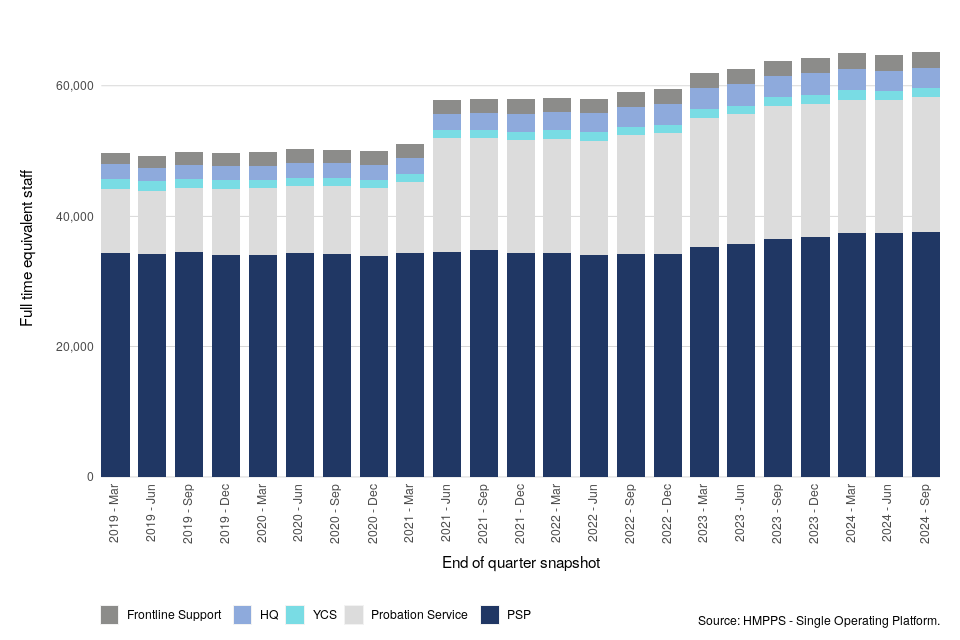
1.1 Length of Service
Due to high numbers of new joiners the average length of service of HMPPS employees has decreased over the last year. Across HMPPS overall, 35.5% of FTE staff in post had less than 3 years’ service, which was a slight increase from 34.6% at 30 September 2023 but no substantial change from 35.4% at 30 June 2024. 32.3% of HMPPS FTE staff in post had 10 years or more of experience, representing no substantial change since 30 June 2024.
The proportion of band 3-5 prison officers with less than 3 years’ service at 30 September 2024 rose to 40.7% compared to 39.3% as at 30 September 2023. The proportion of band 3-5 prison officers in post with 10 years or more of experience decreased by 3.9 percentage points from 28.3% at 30 September 2023 to 24.4% at 30 September 2024. This corresponds to 5,740 FTE staff with 10 years or more of experience at 30 September 2024, which is a fall of 764 FTE, or 11.8% since 30 September 2023.
The proportion of band 2 OSG FTE staff with less than 3 years’ service increased from 51.2% at 30 September 2023 to 53.1% at 30 September 2024, and the proportion of those with 10 years or more of experience decreased from 27.1% at 30 September 2023 to 23.2% at 30 September 2024.
It should be noted, that the National Probation Service was created on 1 June 2014 and service prior to this is not captured in our data. Therefore, the figures relating to the length of service of Probation Service staff, which are included in the HMPPS overall figures, do not necessarily represent their full experience but rather the length of service from entry to HMPPS. The situation is different for the over 7,000 staff who transferred from the CRCs in June 2021 and for them their service prior to their date of transfer is included.
Excluding the Probation Service, 35.7% of FTE staff in post across HMPPS had less than 3 years’ service as at 30 September 2024. This is a slight increase of 1.4 percentage points compared to 30 September 2023. The non-Probation Service staff with 10 years’ experience or more made up 32.1% of the workforce, which is a 2.4 percentage points decrease compared to 30 September 2023.
Length of service information has been calculated for HMPPS staff from the most recent hire date. Where staff have transferred in from another government department or have transferred in through HMPPS taking over a function, length of service is calculated from entry to HMPPS.
2. Band 3-5 prison officers and band 2 operational support staff
23,571 FTE band 3-5 prison officers in post (as at 30 September 2024)
This is an increase of 581 FTE (2.5%) in FTE since 30 September 2023 and small decrease of 42 FTE (0.2%) prison officers compared to 30 June 2024, though this would have been affected by introduction of 254 FTE prison officers in Lowdham Grange.
There has been a more targeted approach to prison officer recruitment in reaction to specific regional staffing requirements focusing on filling vacancies substantively.
5,592 FTE band 2 operational support staff in post (as at 30 September 2024)
This corresponds to an increase of 205 FTE (3.8%) since 30 September 2023 and a slight increase of 36 FTE (0.7%) operational support staff since 30 June 2024.
The key operational grades in public sector prisons are the band 3 to 5 prison officers. They consist of band 3 prison officers, band 4 officer specialists, band 4 supervising officers, and band 5 custodial managers.
Figure 2: Number of band 3-5 prison officers in post on an FTE basis, 31 March 2019 to 30 September 2024 (Source: Table 3)
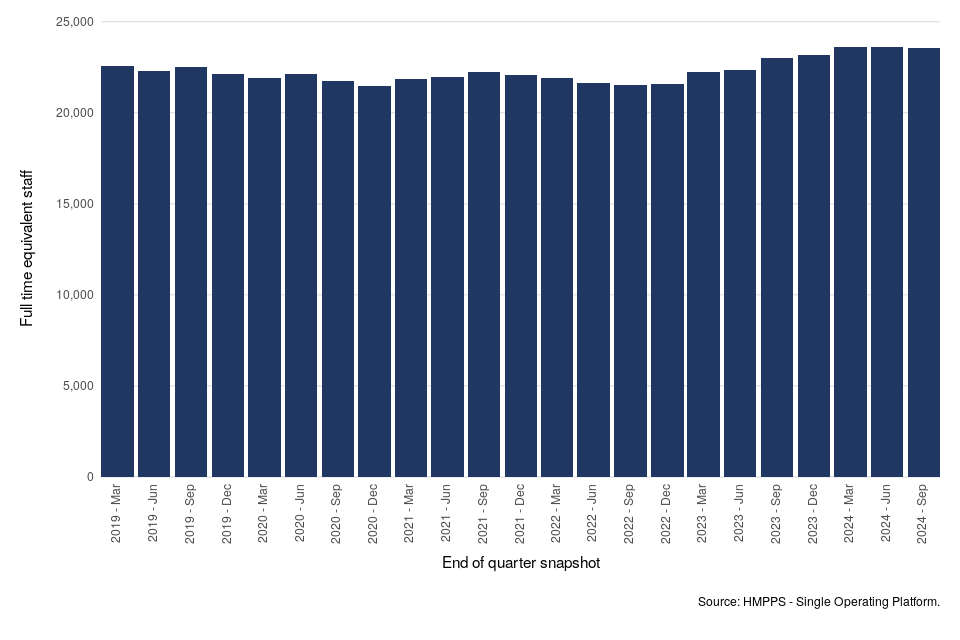
Figure 3 shows a quarterly trend of band 3 to 5 appointments and leavers since 2018/19. Over the year to 30 September 2024, 4,306 band 3 to 5 officers were appointed (consisting of direct new recruits and existing staff who converted to a band 3 officer grade), a decrease of 1,081 (20.1%) compared to 5,387 in the previous year. Looking at the quarterly figures, the headcount of new band 3 to 5 officer appointments decreased by 272 (27.4%) from 994 between April and June 2024 to 722 between July and September 2024 (Table 17).
The headcount of band 3 to 5 prison officers who left HMPPS in the year ending 30 September 2024 was 3,149, which is an increase of 28 (0.9%) compared to the year ending 30 September 2023. Examining reasons for leaving, 66.1% of prison officers who left in the year ending 30 September 2024 resigned from their roles (up from 65.0% in the year ending 30 September 2023). Of the other prison officers who left HMPPS in the year ending 30 September 2024, 18.9% were dismissed and 5.4% retired; the proportion dismissed is up from 15.8% compared to previous year while the number retiring is down from 5.9%.
Figure 3: Newly appointed band 3 to 5 prison officers and band 3 to 5 prison officer leavers, April 2018 to 30 September 2024 (Source: Table 17)
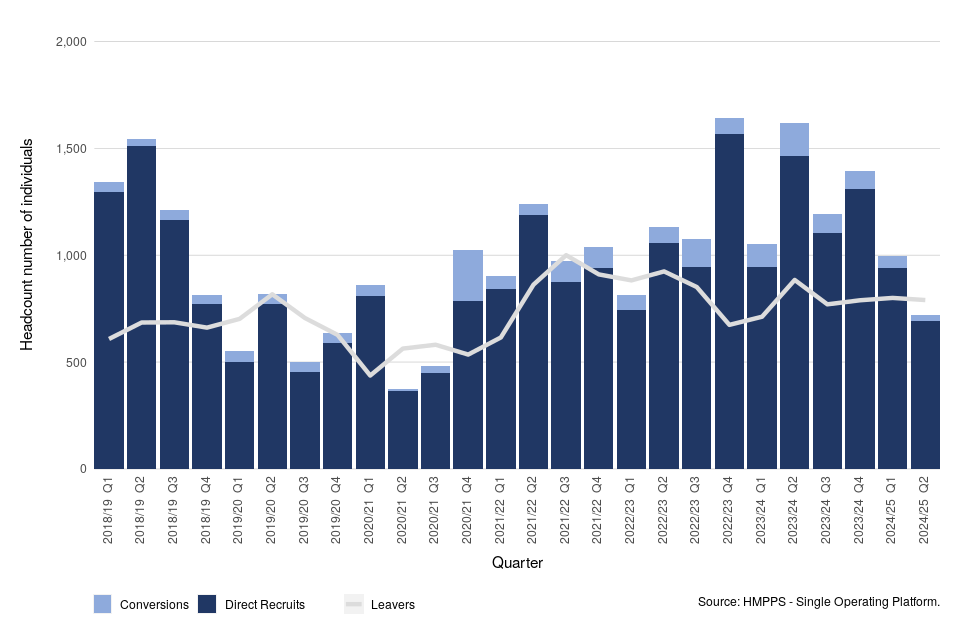
Joiners and leavers are not the only movements into and out of the band 3 to 5 officer grouping. There are also typically differences in the proportion of new joiners and older officers who work part time as well as movements between grades, such as internal movements to non-frontline roles or promotions to operational managers. Changes such as staff switching from full time to part time also have the effect of reducing the FTE of officers available as they progress through their career. For these reasons, the change in FTE does not directly reflect the difference between the number of joiners and leavers.
The number of band 2 OSG staff who joined HMPPS in the year ending 30 September 2024 was 1,447: a decrease of 478 (24.8%) compared to the previous year ending 30 September 2023. There was a decrease of 207 (12.5%) since the year ending 30 June 2024. The headcount number of band 2 OSG staff who left HMPPS was 967, which is a decrease of 9 (0.9%) compared to the year ending 30 September 2023 and a decrease of 2 (0.2%) compared to the year ending 30 June 2024.
3. Probation practitioners and senior probation officers
5,436 FTE band 4 probation officers in post (as at 30 September 2024)
This figure is an increase of 546 FTE (11.2%) since 30 September 2023 and an increase of 276 FTE (5.3%) probation officers compared to 30 June 2024. In addition to the band 4 probation officers, there were 5,586 FTE band 3 probation services officers: a decrease of 1,004 FTE (15.2%) since 30 September 2023 and a decrease of 321 FTE (5.4%) since 30 June 2024.
Key grades in the Probation Service include band 3 probation services officers, band 4 probation officers (collectively known as probation practitioners), as well as band 5 senior probation officers. Staff who are training to be a probation officer work as a probation services officer during their training, so a proportion of the probation services officers in post will be working towards the professional probation officer qualification.
As of the June 2019 publication, a statistics annex has been added to this bulletin which presents figures on Probation Officers in post, their required staffing level, in addition to the number of trainee and qualified Probation Officers.
As at 30 September 2024, there were 5,586 FTE band 3 probation services officers in post, a decrease of 1,004 FTE (15.2%) over the past year and a decrease of 321 FTE (5.4%) over the quarter. Band 3 PSO joiners were lower for the 2023/24 financial year due to the lower number of Trainee Probation Officers starting on a course (543 for 2023/24 compared to 1,514 in 2022/23). For the 2024/25 financial year, we have committed publicly to onboarding at least 1,000 Trainee Probation Officers. There were 5,436 FTE band 4 probation officers, representing an increase of 546 FTE (11.2%) over the past year and an increase of 276 FTE (5.3%) compared to the previous quarter; and 1,494 FTE band 5 senior probation officers, showing no substantial change over the previous year and no substantial change since the last quarter (Figure 4).
Figure 4: Number of probation officers, probation services officers and senior probation officers in post on an FTE basis, 31 March 2019 to 30 September 2024 (Source: Table 3)
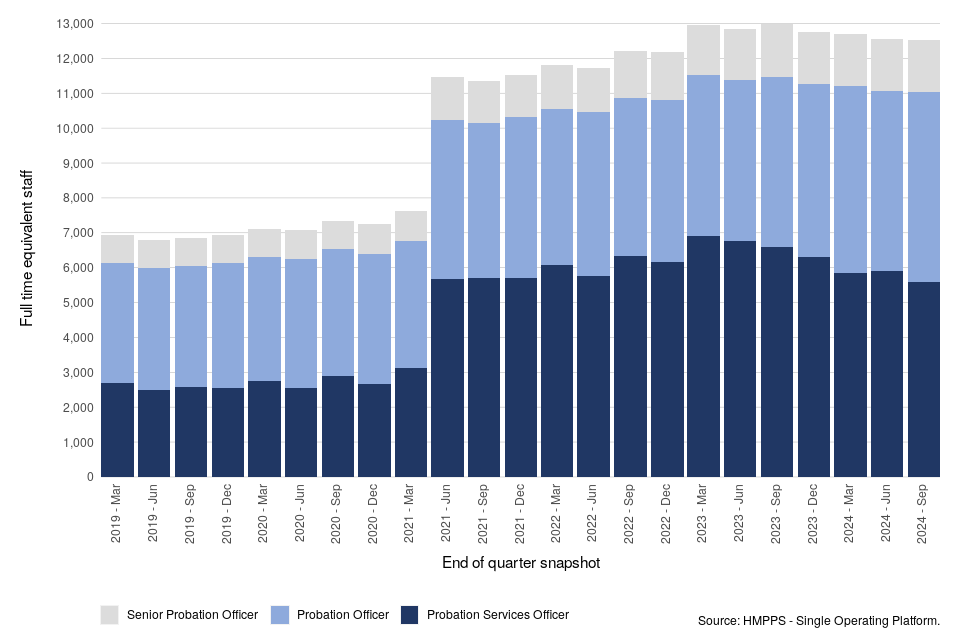
In the past year, 959 probation services officers were appointed, some of whom will be training to become qualified probation officers. This is a decrease of 1,191 (55.4%) compared to the year ending 30 September 2023 and a decrease of 40 (4.0%) compared to the number appointed in the year ending 30 June 2024.
Within the Probation Service, there were 5,413 FTE Probation Officers in post, a shortfall of 1,702 FTE against the target staffing level of 7,115 FTE. There were 1,671 staff, equivalent to 1,641 FTE, undertaking the PQiP training as at 30 September 2024 (please refer to the Prison and Probation Officer Recruitment Annex for more details).
In the past year, 790 probation services officers left the service. This is a slight decrease of 6 (0.8%) compared to the year ending 30 September 2023 and a decrease of 25 (3.1%) compared to the number who left in the year ending 30 June 2024.
4. Joiners and Leavers
Leaving rate of 12.8% amongst band 3-5 prison officers (for the 12 months ending 30 September 2024)
This is a decrease of 0.3 percentage points compared to the year ending 31 March 2024. The overall leaving rate across HMPPS over the past year stood at 11.4%, which is a slight decrease of 0.2 percentage points compared to the year ending 31 March 2024 of 11.6%
Over the past year, 9,408 staff joined HMPPS, which is a decrease of 3,240 (25.6%) compared to the year ending 30 September 2023. These joiners consisted of 6,142 across PSP, 285 in the YCS, 2,690 in the Probation Service, and 291 in HMPPS HQ and Frontline Support. Compared to the year ending 30 September 2023, these numbers of joiners represent a decrease of 19.5% for PSP, a decrease of 21.9% for YCS, a decrease of 37.7% for Probation Service, and a decrease of 13.1% for HMPPS HQ and Frontline Support. Band 3 PSO joiners were lower for the 2023/24 financial year due to the lower number of Trainee Probation Officers starting on a course (543 for 2023/24 compared to 1,514 in 2022/23). For the 2024/25 financial year, we have committed publicly to onboarding at least 1,000 Trainee Probation Officers.
There were 8,221 leavers in the year ending 30 September 2024, an increase of 490 (6.3%) compared to the year ending 30 September 2023. This includes 4,956 leavers from PSP (a slight increase of 1.0%), 229 from YCS (an increase of 5.0%), 2,351 from the Probation Service (an increase of 9.0%), and 685 from HMPPS HQ and Frontline Support (an increase of 53.2%).
4.1 Leaving Rates[footnote 3]
The overall HMPPS leaving rate for the year to 30 September 2024 was 11.4% compared to 11.6% for the year to 31 March 2024 (Figure 5); a slight decrease of 0.2 percentage points. For the year up to 31 March 2021, the increased uncertainty in the employment market following the COVID-19 pandemic may have contributed to the drop in the number of resignations during most of the year, therefore impacting on the overall reduced leaving and resignation rates. Although the latest leaving rates for most grades apart from Senior Probation Officers, are still higher than pre-pandemic levels, most have shown a decrease over the last 12 months.
Figure 5: Annual leaving rates of permanent staff in key operational grades (excluding VEDSR), from the 12 months to 31 March 2019 to the 12 months to 30 September 2024 (Source: Table 11)
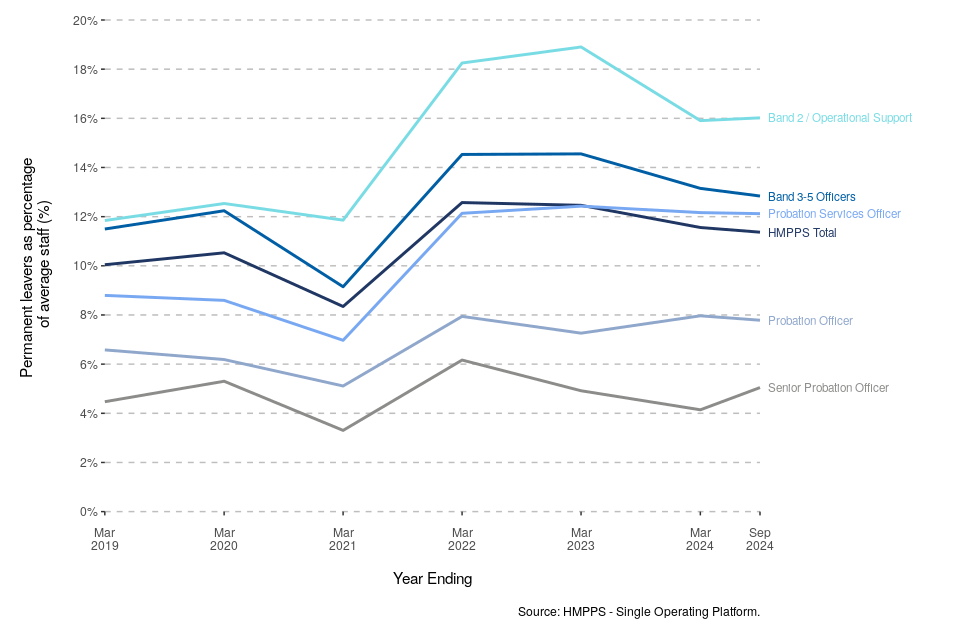
4.2 Resignation Rates[footnote 4]
The overall HMPPS resignation rate for the 12 months to 30 September 2024 was 7.1%, which is the broadly same (7.2%) as for the year to 31 March 2024 (Figure 6). For band 3-5 officers, the resignation rate was 8.5% in the year ending 30 September 2024, which is no change (0.0 percentage points) since the year ending 31 March 2024. The resignation rate for OSG staff was 10.8% for the year ending 30 September 2024, which is a slight decrease of 0.1 percentage points since the year ending 31 March 2024.
For Probation Service overall, the resignation rate was 6.5% for the year ending 30 September 2024. This represents a decrease of 0.3 percentage points compared to the year ending 31 March 2024. Amongst the operational grades within the Probation Service, probation services officers had the highest resignation rate at 8.4%, a decrease of 0.2 percentage points since the year ending 31 March 2024.
Figure 6: Annual resignation rates of permanent staff in key operational grades, from the 12 months to 31 March 2019 to the 12 months to 30 September 2024 (Source: Table 12)
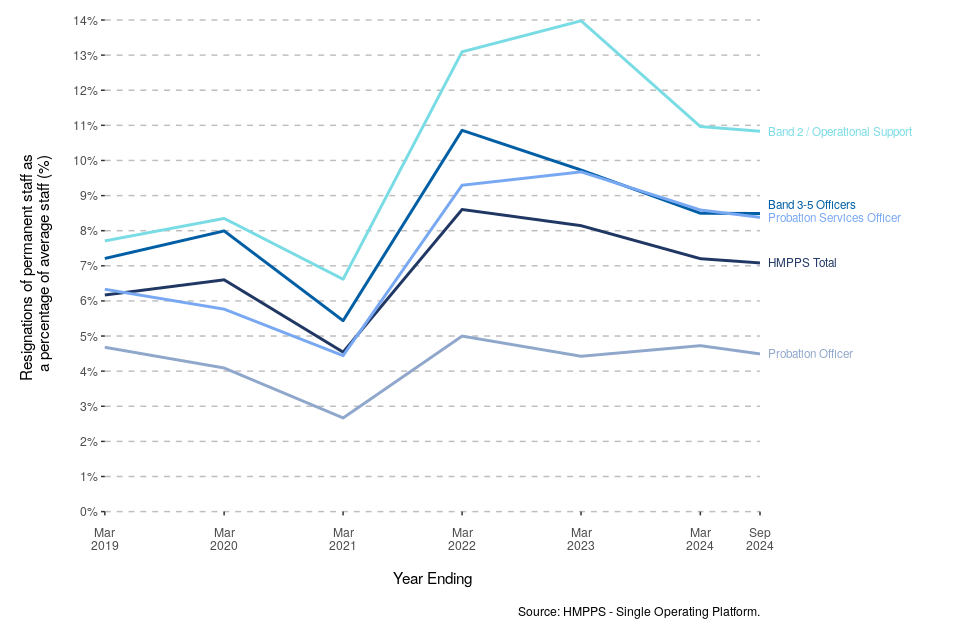
5. Sickness absence
HMPPS staff lost an average of 11.4 working days to sickness absence in the 12 months ending 30 September 2024
This represents an increase of 0.3 Average Working Days Lost (AWDL) compared to the year ending 31 March 2024 (11.2 working days lost).
In the year ending 30 September 2024, HMPPS staff lost an average of 11.4 working days to sickness absence. This is an increase from 11.2 average working days lost for the year ending 31 March 2024, and an increase of 1.2 days compared to the predominantly COVID-19 free year ending 31 March 2020.
YCS staff had the highest sickness absence rate at 17.4 AWDL, followed by Probation Service (13.0 AWDL), PSP (11.1 AWDL), and HQ and Frontline Support (6.4 AWDL) (Figure 7). Compared to the year ending 31 March 2024, these represent an increase of 0.4 days for YCS, an increase of 0.4 days for Probation Service, a slight increase of 0.2 days for PSP, and an increase of 0.4 days for HQ and Frontline Support staff.
Figure 7: Average working days lost to sickness absence, 12 months to 31 March 2019 to 12 months to 30 September 2024 (Source: Table 18)

The most common category of sickness absence in terms of days lost was mental ill health, corresponding to 39.9% of working days lost in the past year. This category was most prevalent for probation officers, where 59.3% of working days lost were attributed to mental ill health.
For HMPPS overall the category that accounted for the second largest proportion of working days lost was musculoskeletal system (17.5%). Together the top two categories accounted for 57.4% of all working days lost.
Further Information
Accompanying files
As well as this bulletin, the following products are published as part of this release:
-
A technical guide providing details of the HMPPS workforce structure as well as how the data are collected and processed. Information on the revisions policy and disclosure relevant to HMPPS staffing data is also included.
-
A supplementary annex presenting statistics on the staff recruited as part of the ‘Great Place to Work for Veterans’ recruitment campaign.
-
A supplementary annex presenting statistics on Probation Officers in post, their required staffing level, and the number of trainee and qualified Probation Officers. In addition, it includes published quarterly hours adjusted Staff in Post, Target Staffing and Difference at establishment level for Band 3-5 Prison Officers.
Accredited Official Statistics
The statistics in this bulletin are classified as accredited official statistics. Accredited official statistics refer to official statistics that have been independently reviewed by The Office for Statistics Regulation (OSR) to ensure they comply with the standards trustworthiness, quality and value in the Code of Practice for Statistics. Accredited official statistics are referred to as ‘National Statistics’ in the Statistics and Registration Service Act 2007. The term ‘Accredited Official Statistics’ to describe national statistics was introduced by OSR in September 2023, following a review of the National Statistics designation.
The Statistics and Registration Service Act 2007 defines ‘official statistics’ as all those statistical outputs produced by the UK Statistics Authority’s executive office (the Office for National Statistics), by central Government departments and agencies, by the devolved administrations in Northern Ireland, Scotland, and Wales, and by other Crown bodies (over 200 bodies in total). The statistics in this bulletin comply with all aspects of the Code of Practice for Official Statistics. The Code encourages and supports producers of statistics to maintain their independence and to ensure adequate resourcing for statistical production. It helps producers and users of statistics by setting out the necessary principles and practices to produce statistics that are trustworthy, high quality and of public value.
Accredited Official Statistics in development
Accredited official statistics in development are a subset of newly developed or innovative official statistics undergoing evaluation. They are developed under the guidance of the Head of Profession for Statistics (HoP) and published to involve users and stakeholders in the assessment of their suitability and quality at an early stage. Therefore, we would like to receive feedback as to how useful they are, whether a different analysis would be preferable, or any other comments about them. If you wish to send any views you may have about these accredited official statistics in development, please use the contact details below.
Contact
Press enquiries should be directed to the Ministry of Justice press office:
https://www.gov.uk/government/organisations/ministry-of-justice/about/media-enquiries
Other enquiries about these statistics should be directed to:
Rob Hartley
Workforce Statistics & Analysis
Analysis Directorate
Ministry of Justice
10 South Colonnade
London
E14 4PH
Email: robert.hartley@justice.gov.uk
Next update: 20 February 2025
URL: www.gov.uk/government/collections/national-offender-management-service-workforce-statistics
© Crown copyright
Produced by the Ministry of Justice
Alternative formats are available on request from robert.hartley@justice.gov.uk
-
This includes staff in Probation Service grades working in other parts of HMPPS. ↩
-
Percentage of staff with a permanent contract of employment who left HMPPS, including individuals who have retired early, but excluding staff who left due to voluntary early departure schemes and redundancy (VEDSR). ↩
-
Percentage of staff with a permanent contract of employment who resigned from HMPPS. ↩
